#pathtozerocarbon, #sustainability
08 – Carbon Negative Activities, Sequestration + Honesty

Go to ClimateEarth, The New York Times, The Wall Street Journal, CBC, and Greenpeace for these carbon offset articles
“A Renewable Energy Credit should not necessarily be used for claims of carbon neutrality”
Green-e Energy
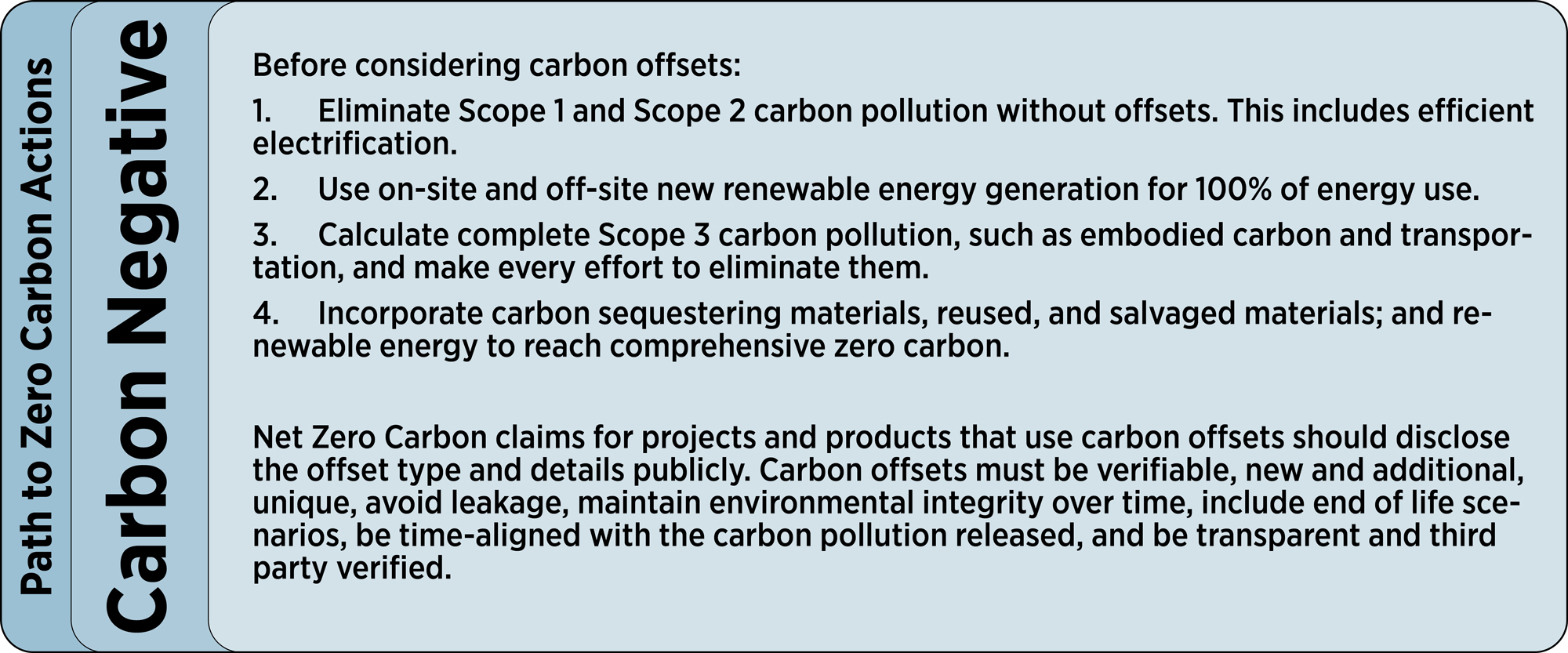
Since buildings are carbon intensive to construct and operate, any carbon neutral project requires some negative carbon numbers to balance carbon pollution to zero. We don’t have a great term yet that includes all these carbon-negative activities, but the list generally includes using carbon-sequestering building products, generating extra renewable energy to displace dirtier grid generation, on-site landscape, and carbon offsets.
Carbon offsets are by far the most popular carbon-negative strategy, from vacation airplane travel to corporate carbon neutrality goals. At their best, the purchaser pays for a lower-cost carbon pollution reduction compared to reducing their own pollution; this is economically efficient and reduces the total cost of climate action. At their worst, they are used to disguise inaction, providing inexpensive and green-sounding carbon claims that do not actually remove carbon from the atmosphere for companies that are choosing not to invest in their own pollution reductions. And many companies have now agreed to limit or avoid using them to reach net zero, while the Science Based Targets Initiative generally does not allow them to substitute for a company’s own carbon pollution. Some journalism suggests that some offsets are ‘junk’, and some research institutions have dropped them as well. How do we discover the difference? Carbon in-setting, where a company reduces its own pollution and supply chain pollution, is always preferable and defensible.
Renewable Energy Credits (RECs) are popular and can reduce a company’s net carbon pollution from electricity, but they are not a carbon negative activity. RECs represent the environmental attributes of 1 megawatt of renewable electricity generation, but not the actual electricity generated. They offer another income stream for developers of renewable energy, who can sell the actual electricity, and then separately sell the RECS. This series claims that both the RECs and the actual electricity generation (often through a Power Purchase Agreement or PPA) should be owned or in a long term lease by an entity in order to claim that a project is powered by clean electricity.
This article includes frameworks and questions for common carbon-negative activities since proving that an activity verifiably reduces carbon pollution from business-as-usual is much more challenging than it seems.
What Are We Looking For?
In the design and construction industry, we have three main options that provide negative carbon numbers that can compensate for pollution to reach a goal of carbon neutrality.
- Use construction products that include carbon sequestration. Though few current products currently show negative Global Warming Potential (GWP, this refers to carbon pollution) in an Environmental Product Data (EPD), many are being researched and formulated toward this end. Some calculations for this are suggested by C.Scale. The amount of time the product is in use, as well as the end of life conditions, are important assumptions in this method.
- Generate Excess Renewable Energy. Generating excess renewable energy that reduces fossil fuel generation on the electricity grid can reasonably count as a carbon negative number. Calculations should show that the extra renewable energy meets criteria in the list below, especially additionality. Renewable energy built years ago and that which would have been built anyway due to economics or regulation is not credible for carbon neutrality claims. Architecture 2030 published a guide here.
- On-site landscape sequestration can also be a useful, carbon-negative strategy when it will remain in place for many decades. Growing plants and trees sequester carbon into mass and soil slowly, if left to grow without too much fertilizer (often made of decomposing elements or fossil fuels) or water. Plantings on elevated terraces are unlikely to be a carbon benefit, as the soil has little chance of storing carbon for a century.
Purchasing voluntary carbon offsets is a questionable last resort. Carbon offsets can be bought for $1.50 per metric ton of CO2e (tCO2e) to $150 per tCO2e and higher. To be blunt, many offset programs fail to meet many basic criteria that align with carbon neutrality goals, which is why some are so inexpensive. The Carbon Offset Guide website is a good resource for terms and concepts; the table at the end has useful questions as well. Another resource is the Integrity Council for Voluntary Carbon Offsets.
Nearly all parts of the economy emit carbon; it follows that a nearly limitless list of activities can be envisioned that reduce carbon pollution. Based on our research, activities (including carbon offsets) that contribute to a carbon neutral project should include these attributes:
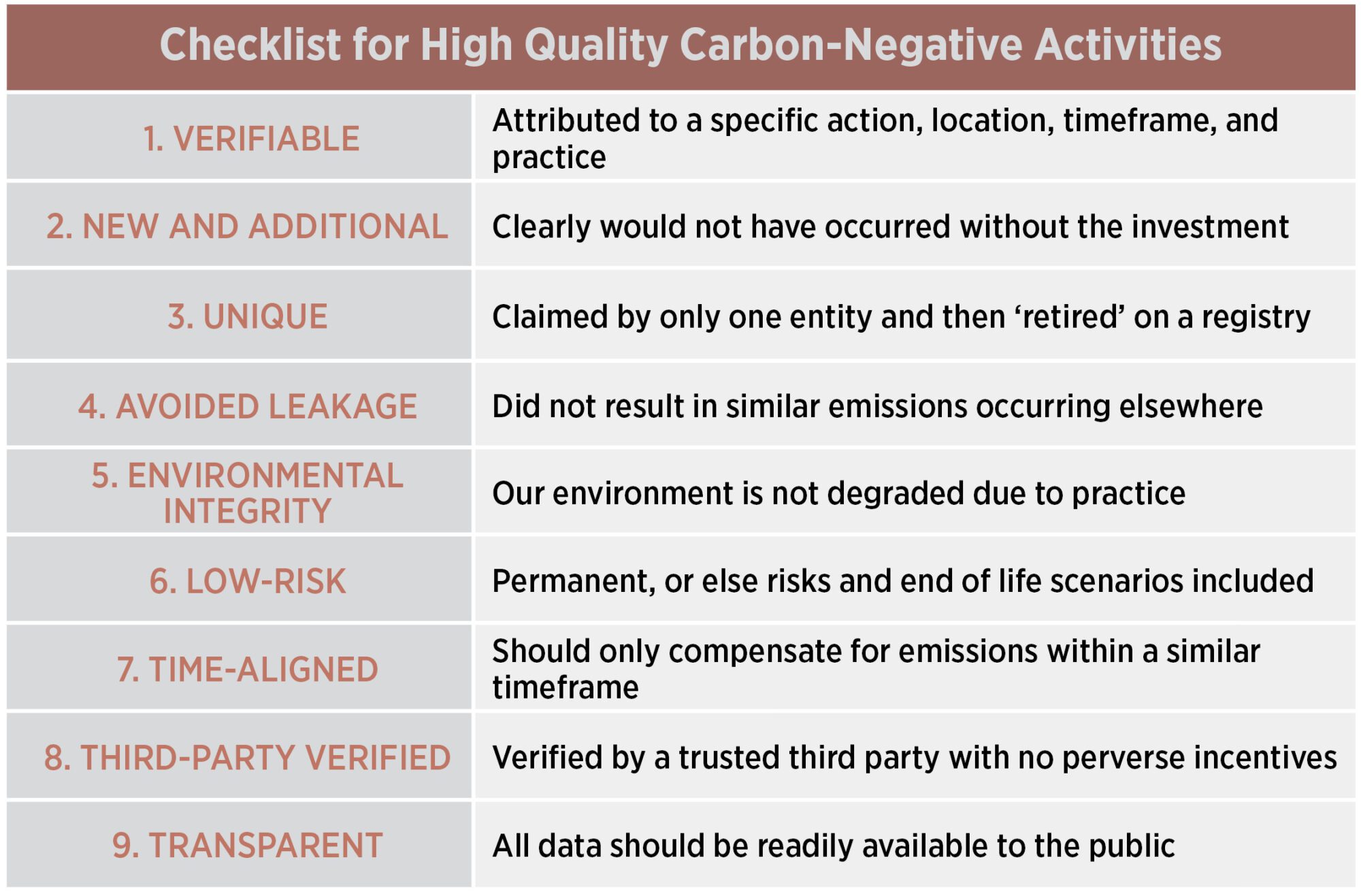
- Verifiable. They should be attributed to a specific action, location, timeframe, and practice.
- New and Additional. Any negative carbon number needs ‘additionality,’ meaning it would clearly not have happened without the investment. The baseline condition (also called a counterfactual) needs to include enacted policies and a reasonable framework. For example, since utility-scale solar and wind energy are low-cost energy sources in many areas and likely to be chosen for new generation sources, they may not provide ‘additionality’ since they are likely to have been built anyway.
- Unique (not double-counted). Two or more entities claiming the same carbon reduction is problematic. Carbon registries track many of the reductions, ‘retiring’ them after they are sold to avoid double counting. But many other opportunities for double counting exist – for example, some forest owners sell carbon offsets based on their good carbon practices; should project teams also take credit for those same practices when they purchase wood from the forest? In the concrete world, Carboncure sells carbon offsets that represent the carbon sequestration in their product; should a design and construction team that uses the product also count the same reductions in their own calculations?
- Avoid leakage. Protecting a forest from clear-cut logging, for example, is not effective if a nearby parcel is clear cut in place of the one being protected.
- Maintain environmental integrity. Our environment should be, in general, no worse off than if the carbon negative activity did not take place. Clear cutting forests for mass timber does not maintain environmental integrity, for example.
- Permanent, Low-Risk or include end of life scenarios. Since many carbon negative calculations are based on future scenarios, risk and end of life scenarios should be integrated into the calculations as well as the benefits of carbon storage. Planting trees to sequester carbon, for example, includes some risk that trees are harvested early or are burned in wildfires. A range of discount rates (perhaps 0%-3%) can also be used to show uncertainty in the future (but not to make future carbon pollution seem unimportant).
- Time-aligned. While this is not industry practice yet, we believe that carbon-negative activities should avoid or remove carbon at roughly the same time (within five yeas or so) as the carbon pollution occurs. Planting trees that sequester carbon over the next 100 years of growth should not be used to cover carbon pollution released today.
- Third-party verified. A trusted third party, with no perverse financial incentive, should verify the claims. Many companies verifying claims have incentives to reduce standards to increase their volume.
- Transparent. All of this information should be readily available to the public alongside any claim
Most of the carbon offset options that LMN reviewed as part of researching this article did not meet many of the above criteria.
Carbon Reduction and Removal Types
So how are the above criteria reflected in frameworks for carbon pollution reductions? The Oxford Principles for Net-Zero Aligned Carbon Offsetting is a primary resource for principles and categorization that applied to any carbon reduction. All negative carbon pollution strategies should begin with their first principle: Prioritize reducing your own pollution, including Scope 3 pollution, before considering offsets.
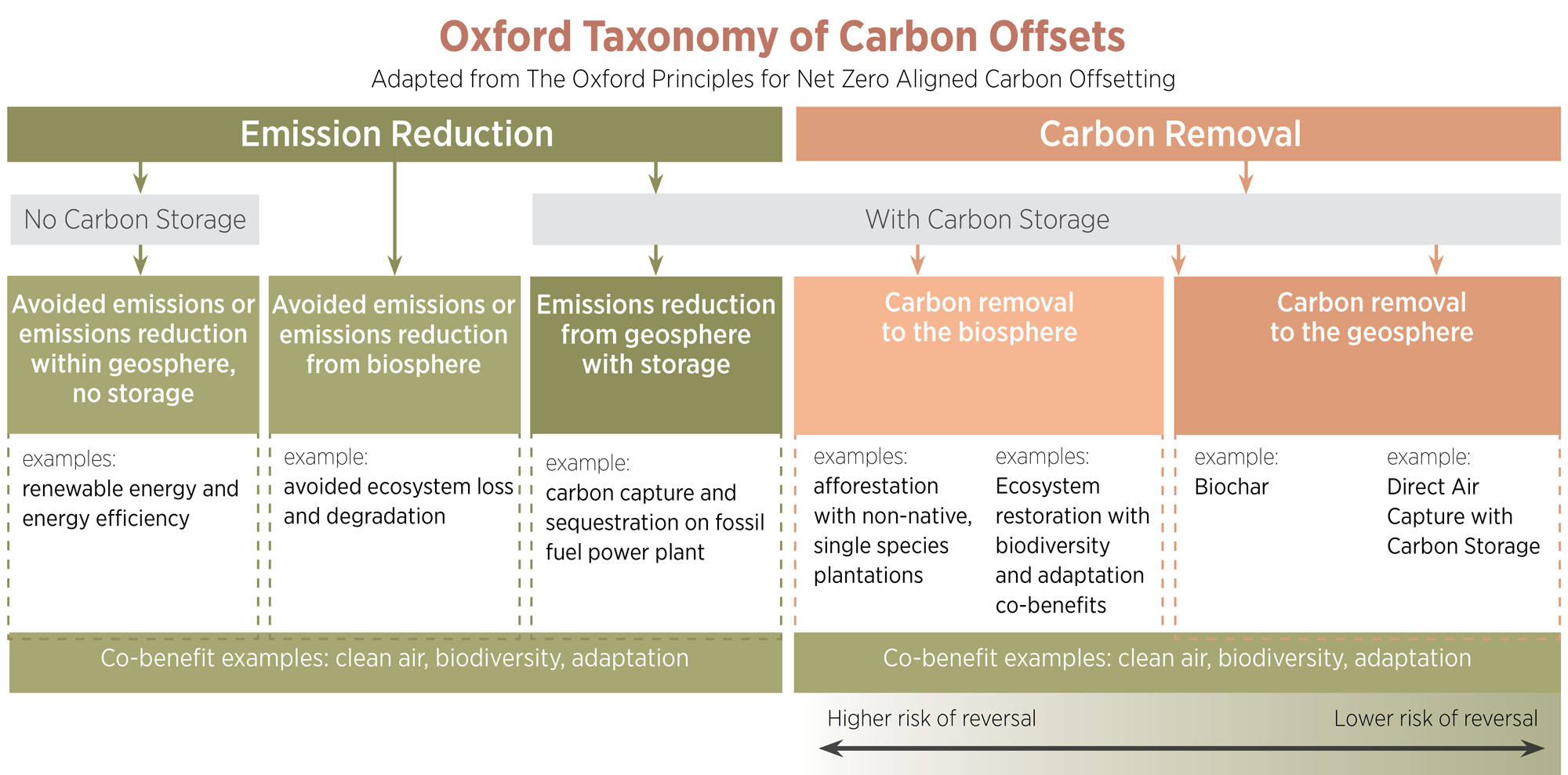
The Oxford taxonomy of carbon offsets helps differentiate among activities that claim to result in negative numbers, including good questions to ask when looking for activities that lead to a reduction in atmospheric greenhouse gases.
Emissions Reduction / Carbon Avoidance include a nearly limitless range of creative reductions. Baselines are challenging for avoidance measures and require thoughtful, critical questions from those who consider purchasing them.
- Renewable energy can displace dirty energy, taking credit for carbon reductions, see the section below on this subject.
- Providing cleaner cookstoves is a popular carbon offset project. Cleaner fuel sources can reduce air pollution (with significant health improvement) as well as total carbon pollution. Like all offsets, ensuring that all criteria are met and that people continue to use the cookstoves and are better off in all ways is critical.
- This searchable list is one of many that shows the breadth of carbon offset projects. Many do not meet the criteria listed above that we believe are essential for carbon neutrality goals.
Carbon Removal with Storage are off site and mostly transactional from the building industry standpoint. Carbonplan provides an interactive summary with critiques. One guide is here.
- Plants have removed CO2 from the atmosphere for millions of years. Agricultural waste, bamboo, and other materials beneficially store this in buildings (and landfills), discussed in the next section.
- Direct Air Carbon Capture and Storage (DAC or DACCS) mechanically removes CO2 from the atmosphere and stores it, often permanently. Many projects are being funded, including some large projects. Critiques include the energy used for this, the permanence of storage, and the challenge of extracting CO2 at a parts per million scale from ambient air.
- Carbon Capture, Use, and Storage (CCS or CCUS) removes carbon equivalents from the direct exhaust stream of fossil fuel power plants and industrial facilities. The removed carbon can be stored in geologic formations or used to produce products, including construction materials such as concrete aggregate. Industrial CCS appears to be a valid method, especially for concrete where around 50% of the carbon pollution is from the chemical reaction that creates cement. Critiques are primarily around energy-related CCS: Nearly all CCS from power plants often don’t work out economically and some captured CO2 is used to extract more fossil fuels that increase carbon pollution.
- Planting or protecting forests and other land use. While an important part of environmental stewardship with many co-benefits, we can’t plant enough trees to soak up the fossil fuels that we currently burn.
- Bioenergy with Carbon Capture and Storage (BECCS) extracts plant-sequestered carbon for energy use and stores remaining carbon as biochar. It is not likely scalable.
Biogenic Carbon to the Rescue?
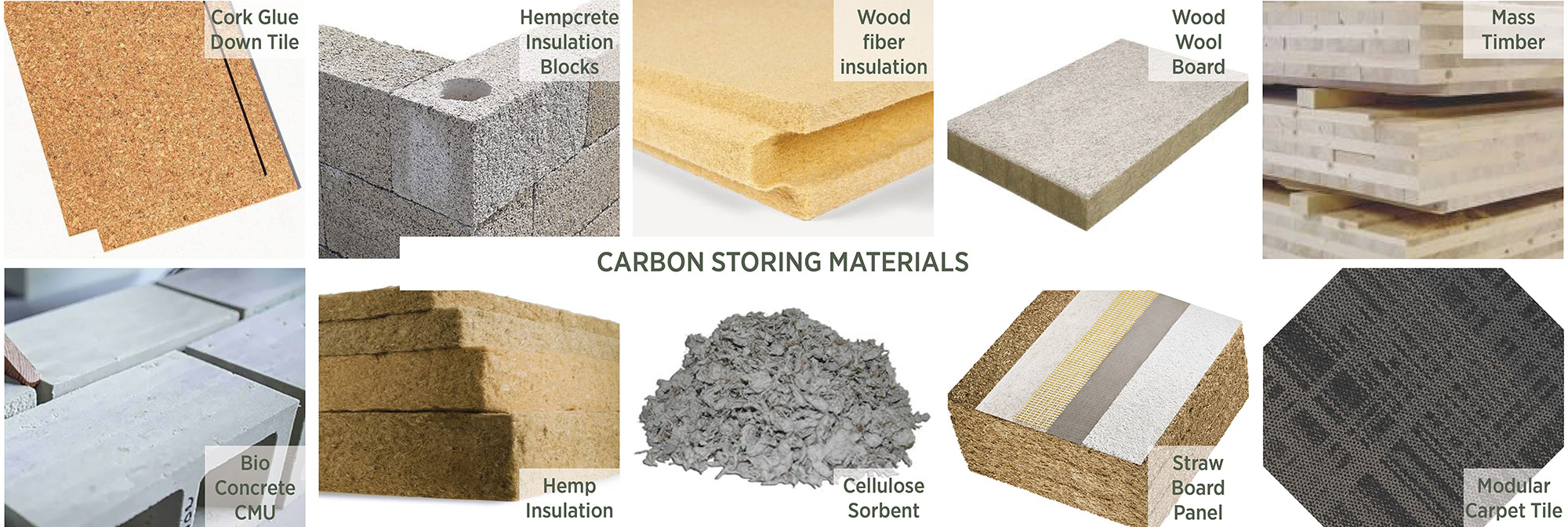
(Cork Glue Down Tile, Hempcrete Insulation Blocks, Wood Fiber Insulation, Straw Board Panel, Wood Wool Board, Hemp Insulation, Bio-concrete CMU, Glued Laminated Timber, Modular Carpet Tile) According to Build Beyond Zero straw (a waste product) could be incorporated into building materials as a "carbon sink" to absorbs approximately 1 billion tCO2 per year.
Pulling carbon dioxide out of ambient air is critical to most carbon neutrality scenarios. While machines that remove carbon from the air are attracting significant investment, living plants using photosynthesis have been doing this for millions of years around the world, every day. In fact, the climate is stable today because vegetation over millions of years has sequestered carbon via plants and stored it in the ground as fossil fuels. The carbon sequestered by plants is called biogenic carbon (CLF research here) also discussed in Post 07.
While mass timber has grabbed headlines, agricultural waste products represent the largest opportunity for the positive impact of biogenic materials. There is not enough timber in the world to make all buildings with timber structure, and only a small percentage of all forests have the best forest management practices that maximize carbon sequestration in wood and land. Agricultural waste (and bamboo) is much more plentiful, can be made into a wide variety of construction materials, and has a much shorter grow cycle compared to timber.
With proper accounting, some products use biogenic carbon removed from the atmosphere to become truly carbon negative. The construction industry, expected to add new floor area equal to that of New York City every month over the next 40 years, offers a massive opportunity to lock up atmospheric carbon within these products.
Biogenic carbon accounting is very complicated and difficult to summarize, however. Here is a list of things that are true, concise, and useful. Thanks to the CLF message board for input.
- A cradle to grave analysis usually shows a product’s carbon pollution summing to zero due to end-of-life incineration or decomposition, but some end-of-life scenarios continue to store carbon. Cradle-to-gate (A1-A3) analyses help understand carbon stored during a product’s service life. Architects tend to work on higher quality buildings that will last longer than typical LCAs estimate (60 years), so biogenic carbon storage in structure and envelope may have more storage value than is estimated.
- Many products sequester more CO2 than they weigh. How? They absorb CO2, release the O2, and store the carbon. Since carbon dioxide weighs 3.7 more than carbon, a product (like some mass timber) that is 50% carbon can sequester 1.833 kg CO2 per 1 kg of wood within a final timber product.
- Biogenic materials need to consider both attributional emissions within EPDs as well as consequential emissions that are carbon outside of the scope of an EPD and more difficult to track down. For mass timber structures, land management can result in higher total emissions similar to steel or concrete structures, for example, or with significant additional carbon sequestration. Land can also sequester additional carbon using conservation agriculture practices, for example.
- There is no standard for biogenic carbon storage quantities for EPDs or within WBLCA, although ISO 21930 and a supplement provide some guidance. EPD rules generally require biogenic carbon to be re-released to the atmosphere within the EPD modules provided, meaning that all biogenic carbon nets to zero within the EPD.
- Agricultural and wood waste can be used to create products that store carbon. These are often short-rotation crops or small diameter wood from the thinning of forests, with wastes that are generally fibers. According to Build Beyond Zero, 2.2 billion tons of straw (a waste product) sequesters carbon roughly equal to India’s annual carbon pollution – incorporating this into building materials has a potential massive impact in drawing down global carbon pollution.
- Purpose grown biogenic stocks should not compete with food systems for land use. They should include carbon pollution from creation and use of fertilizers, planting, tilling, and harvesting. Agricultural waste products (and from thinning of forests) should include a smaller, prorated portion of these inputs.
- For short-rotation crops, carbon is sequestered in roughly the same year the product is produced, so the storage begins immediately. For long-rotation crops such as trees, accounting for when the carbon is sequestered is complicated, see below.
- Location matters. Practices that support biogenic carbon sequestration in one area may not work as well in others. Local ecosystems should be supported.
- Demolition of biogenic products during renovation and demolition may result in significant pollution. Investigate end of life scenarios and consider reuse or continued storage of the biogenic material.
- Wood carbon sequestration can be calculated 3 ways: 1) taking credit for carbon stored in the wood fibers, essentially carbon stored over the last 20-200 years. 2) taking credit for future carbon storage of trees that are planted in place of ones harvested. This takes credit for carbon removals over the next 1-100 years. 3) Taking credit for a net growth of total forest stock in a region or country. This is the only time-aligned story, but takes credit for others’ work. If this is the story told, net growth should be regional or local and be paired with non-clear-cutting forest management practices to avoid releasing soil-stored biogenic carbon. When wood is harvested, perhaps half of the above-ground carbon stock is released back into the atmosphere as decomposition or combustion of bark and waste wood.
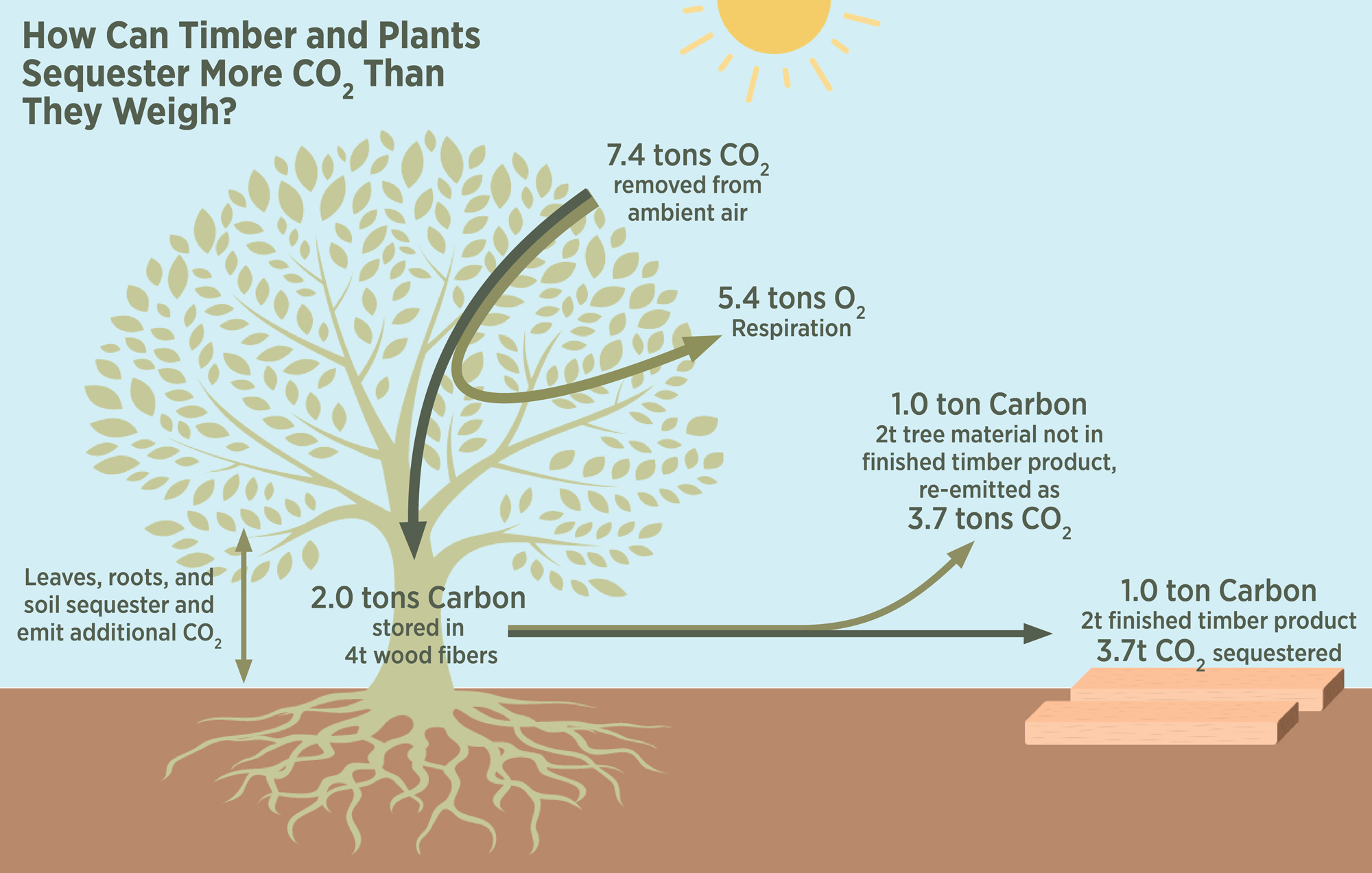
How do biogenic products weigh less than the CO2 that they sequester? Photosynthesis breaks apart CO2 into O2 and C (elemental carbon). The elemental carbon weighs 3.7 times less than the original CO2 and is stored in the fibers that are used in building products. For a wood product that is roughly 50% elemental carbon, the result is that approximately 1.83 tCO2 is sequestered in only 1 metric ton of finished product.
Before you accept marketing claims about carbon-neutral or carbon-sequestering products, look at the EPD to understand the GWP impact of A1-A3 stages. If the A1-A3 GWP impact is greater than zero, this is an indicator that the company’s carbon neutrality claims may be relying on carbon offsets instead of direct decarbonization of the manufacturing process and incorporation of biogenic materials. Offsets should not be reflected in EPD data. A negative A1-A3 GWP suggests incorporation of biogenic materials that may support carbon neutrality claims, although if A1-A3 are the only modules reported they are required to include any biogenic carbon being released at end of life.
Land management carbon pollution and sequestration where the biogenic carbon is grown is excluded from EPD data and yet has real consequences. For example, if a wood product is extracted through deforestation or clear cutting, the carbon pollution released from the soil from the land use change will likely negate the biogenic carbon stored in the wood (and this pollution is not reflected in EPDs).
- Videos on wood and carbon by the Carbon Leadership Forum and CLF-Seattle
- The Upstream Tool helps estimate biogenic carbon scenarios for wood products, building on existing methods and research and adding an A0 module for forest carbon impacts
- Biogenic carbon is an area of significant research for manufacturers as well as the Department of Energy
- Woodworks has many resources on biogenic carbon
- The US Department of Agriculture BioPreferred program certifies products with biobased content
Energy Related Purchasing: RECs are Not Offsets
Purchasing 100% renewable energy is a critical part of reaching carbon neutrality, but in general it should not be used for negative carbon numbers outside of electricity use calculations (Post 06 and Post 13 get into more detail). Sales of certified off-site renewable energy have grown to nearly 100 million MWh annually in the last two decades.
Renewable Energy Credits (REC) are an energy-related purchase. RECs represent only the ‘environmental attributes’ of 1 MW (megawatt) of renewable energy and are often sold separately from the renewable energy itself. They do not (by themselves) meet the criteria above for carbon neutrality claims as they do not need to prove additionality; research suggests that many RECs are not creating additional renewable energy. RECS do not fund the entire cost of new renewable energy, just the green premium (or incremental cost) above the cost of traditional energy sources. Since renewable energy is now cheaper than fossil fuel energy in most of the US, there is no green premium, meaning that RECS by themselves (referred to as unbundled RECS) are simply providing another income stream for renewable energy developers. RECs are tracked in registries and considered ‘retired’ when they are purchased to avoid double-counting.
Power Purchase Agreements (PPA) are a contract to purchase energy from a specific source for a specified length of time. Some are called ‘virtual’ power purchase agreements (VPPA) when the purchased electricity often does not flow directly to the user. New renewable installations often meet all the requirements under ‘What are we looking for?’ for and are appropriate for balancing on-site energy use with off-site energy procurement. All renewable energy purchased with a PPA toward a goal of carbon neutrality should also retain the RECs associated with their purchase. PPAs are generally for very large corporations, but community solar is an accessible form of PPA and some utilities offer high-criteria 100% renewable power. This is a good primer on the challenges of off-site renewable energy purchases. Resources include: Renewable Energy Buyer’s Alliance, LevelTen, 3Degrees, Customer First Renewables, and Schneider Electric.
Since PV generation can be less than $1.50/kW installed at utility scale, and one kW generates in excess of 1MWh of electricity annually, a PPA (that inherently includes RECS) can be less expensive than some unbundled RECs depending on the market.
Renewable Fuel Certificates (RFC) are similar to RECs but are supported by Green-e for renewable fuels from biogas and methane capture, often at landfills or concentrated animal feedlots. Landfills and some industrial and farm-related uses emit methane, a potent greenhouse gas. This methane can be captured and used in place of fossil fuels (some examples) or burned off to convert it from methane to CO2 pollution. RFC purchases are still new and uncommon.
Carbon Offsets: The Questionable Last Resort
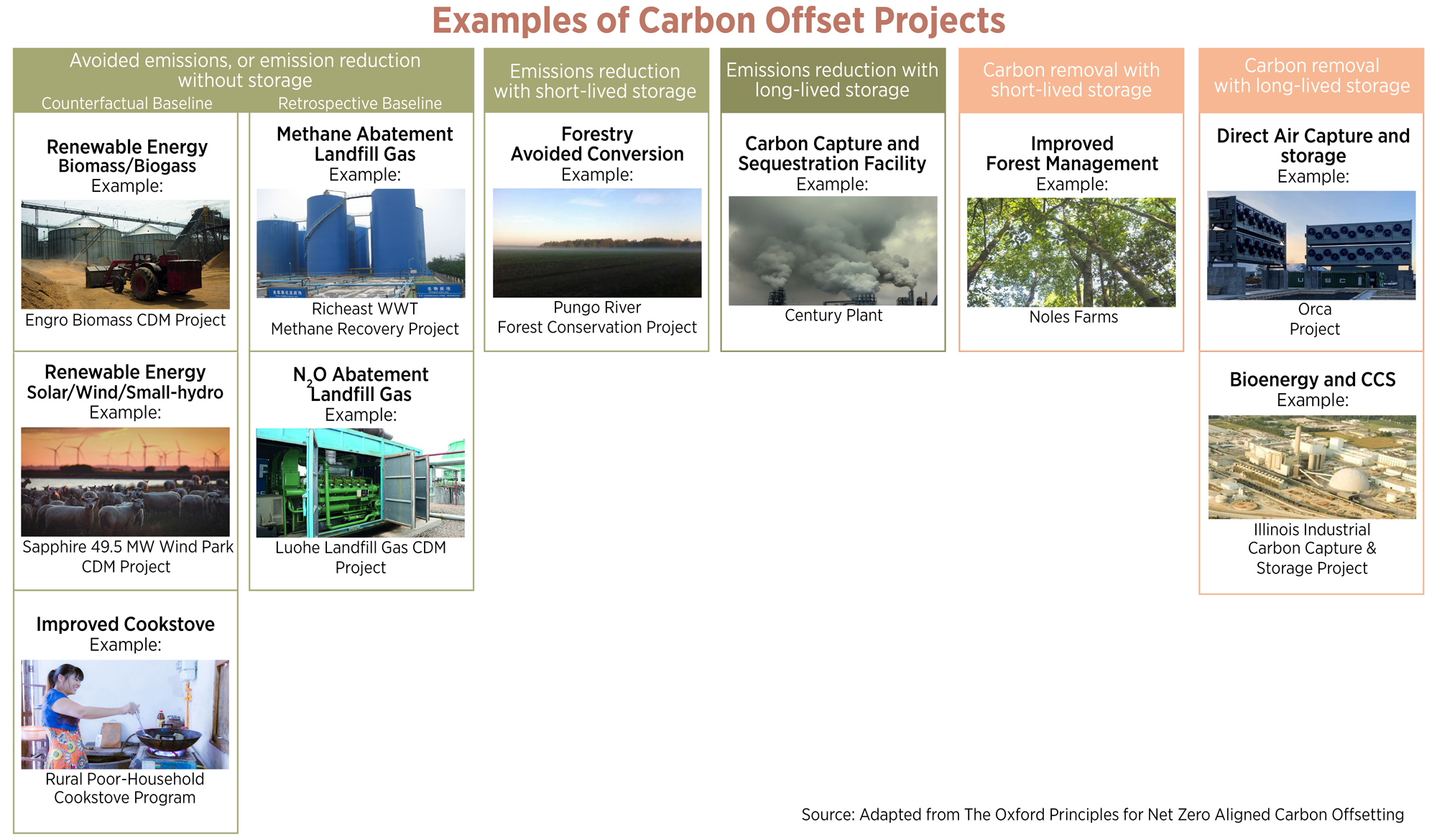
Carbon Offset project examples include: Engro Biomass CDM Project, Sapphire 49.5 MW Wind Park CDM Project, Low-pollution cooking fuel projects, Richeast WWT Methane Recovery Project, Luohe Landfill Gas CDM Project, Pungo River Forest Conservation Project, Century Plant, Noles Farms, Orca, Illinois Industrial Carbon Capture & Storage Project Note that Orca, over the first 4 years, has not removed as much carbon as was emitted for energy to power it, Stratos was abandoned after more than a decade, while Illinois Industrial has failed to meet initial goals.
The theory of offsets is simple: since climate change is a global problem, reducing or sequestering carbon anywhere can be used to ‘offset’ carbon emitted elsewhere. This allows the cheapest pollution reductions or removals to be realized first, creating a transfer of money across borders, often via a carbon offset (aka carbon credit), which is a packaged asset that represents carbon removal or avoidance measured in metric tons of CO2e.
The reality is much more complicated: very few of these packaged assets meet the principles outlined in ‘What are we looking for?’ because the criteria are complicated and require significant verification. All parties have an incentive to overstate the impact of the carbon offset. Many carbon offsets don’t do everything they claim, meaning they are taking money but not reducing carbon pollution as much as is claimed.
Carbon offsets can be part of voluntary programs, meaning that they are created and verified by the market, or within mandatory programs, meaning they additionally need to comply with other policies such as California’s Cap and Trade program or a state’s renewable portfolio standard. This post focuses on voluntary programs.
The UN Clean Development Mechanism creates and updates standards for carbon offsets in developing countries, including Certified Emissions Reductions (CER, for use within the Kyoto protocol) and Verified Emissions Reductions (VER, voluntary market, outside the Kyoto protocol).
The process of creating a carbon offset is complicated and involves many parties. A buyer of carbon offsets primarily will need to interact with the vendor but will look at documents prepared by the verifier and other up-stream parties to assess the validity. The rigor of a carbon offset is set by one of several ‘Carbon Offset Programs’ that develop standards that set criteria, review projects against the criteria, and operate registries to ensure each credit is sold only once. A few of these registries are listed below:
The transparency of the Carbon Offset Programs above can be verified by the Center for Resource Solutions that operates the Green-e® program. USGBC (LEED), the International Living Future Institute (ILFI), and other certification bodies require carbon (Green-e Climate) and renewable energy (Green-e Energy) products to meet this standard. Green-e provides an additional review and requires certain disclaimers to be on a product but ultimately is only certifying the transparency of the offset, not the validity of the offset itself. One of the biggest differences between LEED and ILFI requirements is that LEED v4 accepts REC-only purchases to satisfy EA: Renewable Energy as well as the energy portion of the LEED Zero Carbon and Zero Energy Programs. In addition to retiring the RECs, ILFI programs require the renewable energy source to be new and solely attributable to the project via a (minimum) 15-year agreement, often this is through a VPPA described above.
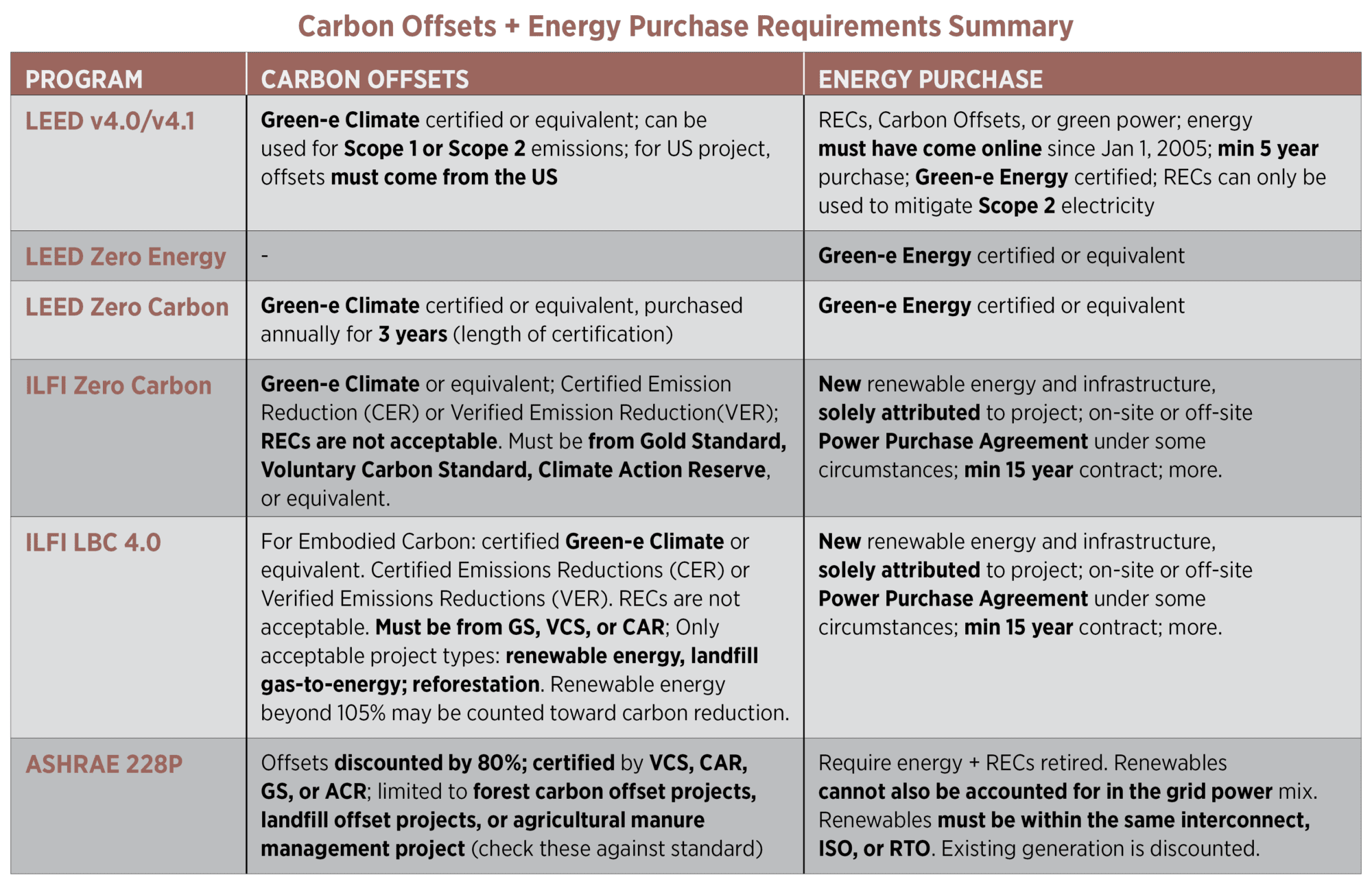
Summary of several certification requirements for carbon offsets and energy procurement. References include: Green-e Climate, Green-e Energy, Certified Emission Reduction, Verified Emission Reduction, Gold Standard, Verified Carbon Standard, Climate Action Reserve, American Carbon Registry
Note that carbon reduction strategies typically used on construction projects, such as improved envelopes and HVAC systems, material optimizations, and low-carbon and biogenic materials, are not typically packaged and sold as carbon offsets even though they are more real and verifiable than most carbon offsets. There are efforts to incentivize these strategies by doing so. Aureus Earth, for example, packaged mass timber carbon as high-quality offsets. Our industry is still trying to determine how this may affect double-counting within carbon claims.
Conclusions and Recommendations
Any carbon neutrality goal involves negative carbon numbers – through carbon-negative products, renewable energy, landscape, or carbon offsets. This last one deserves special scrutiny in carbon neutral goals to avoid masking inaction and dubious claims. Economics plays a role: because carbon offsets are difficult to verify by the purchaser, the market is incentivized to overstate reductions and not report failures. And the resulting too-good-to-be-true offsets are often far cheaper to buy than reducing a company’s direct pollution. The quality of offsets, and other negative carbon numbers, is especially important as more products and companies claim carbon neutrality through their use.
Recommendations
- Reduce directly controlled pollution first, especially Scope 1 and 2 (Post 02). Use Virtual Power Purchase Agreements, (not RECs alone) or similarly structured purchase for energy-related carbon reduction.
- Procure low-carbon and carbon-sequestering building materials.
- After all carbon reduction measures are in place, use carbon offsets for remaining Scope 3 pollution, asking questions from the criteria in the ‘What are we looking for?’ section.
- Where possible, align carbon sequestration timeframe with the time of carbon pollution.
Remaining questions
- What higher standards exist to ensure that carbon offset purchases meet all essential criteria to avoid greenwashing and fully support claims of carbon neutrality?
- How can carbon offset markets provide better transparency on the quality products they are offering towards robust carbon neutrality claims?
- How soon will biogenic, carbon-sequestering material make it to market at scale and with verified EPD documentation?
Please email any questions or comments to Kjell Anderson, kanderson@lmnarchitects.com
Thanks to our external collaborators and peer reviewers
Meghan Lewis, CLF; Pat Brewer, Green-e; Chris Hellstern, Miller Hull; Victoria Burrows, WorldGBC; Pamela Conrad, Climate Positive Design; Jen Snook, CEBA; Tiffany Mayville, CEBA; Alex Ianchenko, Miller Hull; David Mead, PAE; Evan Ponto, OAC; Andrew Sahl, OAC; Chris Magwood, RMI, Kim Shinn, TLC Engineering
LMN Architects Team
Huma Timurbanga, Justin Schwartzhoff, Jenn Chen, Chris Savage, Andrew Gustin, Kjell Anderson
Posted: 11/15/2022
Edited: 10/09/2025
The text, images and graphics published here should be credited to LMN Architects unless stated otherwise. Permission to distribute, remix, adapt, and build upon the material in any medium or format for noncommercial purposes is granted as long as attribution is given to LMN Architects.